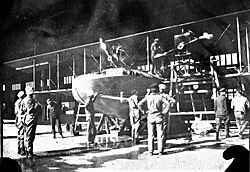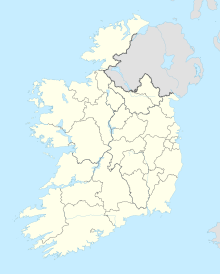U.S. Naval Air Station Lough Foyle Ireland facts for kids
Quick facts for kids
NAS Lough Foyle
|
|
|---|---|

US NAS Lough Foyle (UA 557.05 Marian Shippey Cote Collection)
|
|
| Summary | |
| Airport type | Military |
| Operator | United States Navy |
| Location | Lough Foyle, near Quigley's Point, County Donegal, Ireland |
| Built | 1918 |
| In use | 1918–1919 |
| Elevation AMSL | 3 ft 3 in ft / 1 m |
| Coordinates | 55°06′15″N 007°12′47″W / 55.10417°N 7.21306°W |
| Map | |
U.S. Naval Air Station Lough Foyle was a special base for seaplanes (planes that can land on water). It was located at Lough Foyle in Ireland. The United States Navy (USN) ran this base. It opened on July 1, 1918, during World War I. Commander Henry D. Cooke was in charge. The base was near Quigley's Point in County Donegal, about 6 miles north of Derry. It closed down in early 1919.
Why the Base Was Built
When the United States joined World War I, they needed places to help fight enemy submarines. These submarines were a big threat to ships crossing the ocean. Five spots in Ireland were chosen for US Navy bases. These included Lough Foyle, along with Queenstown, Wexford, Whiddy Island, and Berehaven.
Local Irish workers and American builders worked together to create the base. They built a control tower, which you can still see today. They also made living areas and workshops for the base staff. A concrete ramp, called a slipway, was built for moving the seaplanes in and out of the water. This slipway is also still there.
The Aircraft Used
In July 1918, the first planes arrived at Lough Foyle. These were large seaplanes called Curtiss H-16 flying boats. They came in pieces and had to be put back together. This job was finished by August 22, and then pilot training began.
The base officially started its operations on September 1, 1918. From September 3 to November 6, the flying boats flew 27 patrols. They could only fly on 31 days during that time, usually due to weather. The longest patrol lasted over six hours, happening on October 24.
Exciting Missions
The main job of the seaplanes was to find and stop enemy submarines. On October 19, 1918, something exciting happened. Ensign George S. Montgomery was flying a patrol. He was helping to protect a group of 32 ships near Lough Foyle.
Ensign Montgomery spotted an enemy submarine that was trying to attack the ships. He quickly attacked it with bombs. His bombs landed very close to the submarine's periscope (the part that sticks out of the water). This caused a lot of water movement and oil to appear on the surface. Because he likely damaged the submarine and saved the convoy, he received an official commendation (a special thank you).
The Base Closes
World War I ended, and the US Naval Air Stations in Ireland were no longer needed. The patrols to find submarines stopped. The planes were put away and their weapons removed. NAS Lough Foyle officially closed on February 22, 1919.
See also


